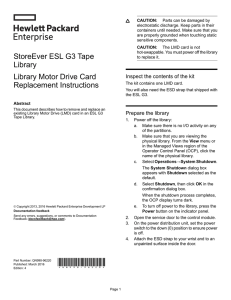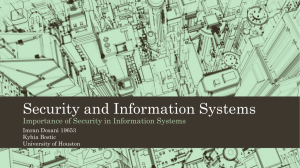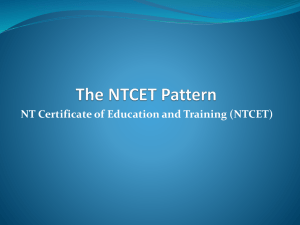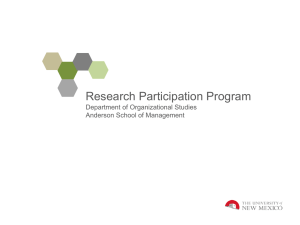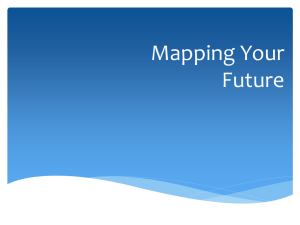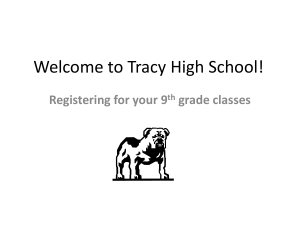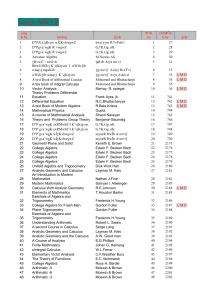to the presentation - Educational Research Center
advertisement
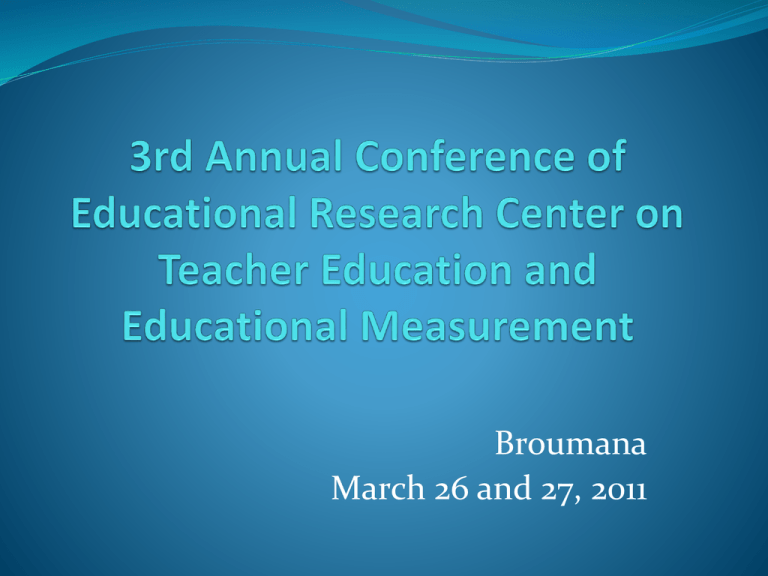
Broumana March 26 and 27, 2011 Zalpha Ayoubi March 27, 2011 Outline Teacher Education in Lebanese University The New LMD System LMD at the Lebanese University LMD at the Faculty of Education Problems in Implementation Challenges Teacher Education in Lebanese University The Lebanese University was established in 1951 to serve the diverse social groups that make up Lebanese society. The first department was The High Teachers Institution which was then replaced by the Faculty of Education. Secondary School Teacher Preparation Five-year program following High School. In 1980: 2 years following License (Equivalent to a Masters degree) In 2003: 1 year following Bachelor degree In 2011: The new LMD professional Master: 2 years after License Elementary School Teacher Preparation Started in 1988 as general education preparation 1997 curricula: replaced the general elementary teacher preparation with specialized preparation on the basis of the cycle and the teaching subjects. There was balance between the general common courses and the specialized course. (total 120 credits, 1560 hours) In 2008 : The new LMD system curricula LMD System The LMD system is an organizational framework for university courses which is currently being implemented in European countries. The term LMD (License - Master - Doctorate) corresponds to the application of the principles for implementation of the European Higher Education Area as defined by the Bologna process. Aims of the LMD system To allow for the comparison and harmonization of European qualifications. To promote student mobility. To improve the transparency of qualifications on the job market. Main aspects of LMD Courses are organized by semesters, Courses are designed along study paths, with a logical progression, The study paths are made up of a combination of Courses which are either compulsory, optional or free. The successful completion of a Course is rewarded with credits known as ECTS (European Credit Transfer System) which can be transferred and are accumulated. The ECTS reflect the overall workload of the student (courses, experiments, class work, personal work, etc.) LMD at the Lebanese University (1) LMD system was adopted by the Lebanese University in 2005 (decree 14840). Reasons: To unify the educational system at the LU To be in alignment with the European new system To have a more flexible system (departments and faculties) To be open to the job market (qualifications of the graduate) LMD at the Lebanese University (2) University Degrees: Licence (Bachelor) Master: Professional and Research Doctorat (PhD) Credit System: One credit is equivalent to 20 hours (total student workload) Each semester is composed of 30 credits LMD at the Lebanese University (3) Courses: One course represents the teaching unit dealing with one subject area during one semester. Each course is composed of 2-6 credits. Courses are either obligatory, elective or free Obligatory courses: more than 120 credits Free courses less: than 20 credits Distribution of course hours according to lectures (focus on theory) and classwork (Travaux Dirigés or TD and Travaux Pratiques or TP) LMD at the Lebanese University (4) Updating the specialties and content of courses Adopting new teaching and assessment methods: student-centered approaches to teaching and learning continuous assessment Teachers are required to review their teaching and assessment methods individually and collectively LMD at the Faculty of Education (1) The LMD courses are organized into three levels. : Licence: 6 semesters (3-5 years of study) Master: 4 semesters (2-4 years of study) Doctorate : 6 semesters of research (3-5 years of study) In Licence, students are expected to attend 300 hours in a 13 week period (i.e. 23 hours/week). In Master, students are expected to attend 210 hours in 14 week period (i.e. 15 hours/week) Master: professional and research LMD at the Faculty of Education (2) License Specialties: Teaching of Arabic Language at the Elementary Level Teaching of French Language at the Elementary Level Teaching of English Language at the Elementary Level Teaching of Mathematics at the Elementary Level (French and English) Teaching of Science at the Elementary Level (French and English) Teaching of Social Studies at the Elementary Level Early Childhood Education (French and English) Physical and Sports Education Music Education Art Education Distribution of Credits 68 37.8% 24 10 34 ( 8 )10 70 38.9% 36 20% 6 3.3% 180 36 34 )10 + 24( 20 + 16 )4 + 12( + ) ( Distribution of Credits (ECE) 70 38.9% 84 46.7% 20 11.1% 6 3.3% 180 24 12 34 62 22 )10 + 12( ) + 4 8 8( Distribution of Credits (Sports, Music, Art) 66 36.7% 88 48.9% 20 11.1% 6 3.3% 180 24 10 32 46 42 Course Syllabus (1) Course Name: Strategies for Teaching Science 1 Code: No. of Credits: 4 Language of Instruction: English/French Teaching Hours: 40 Teaching Hours Distribution: TH (28) ; TD (12) Course Syllabus (2) 1. General Objectives 2. Intended Learning Outcomes 3. Course Outline 4. Methods of Teaching 5. Evaluation 6. References Problems in Implementation Students are overwhelmed with the heavy load they have. Many instructors did not change the lectures’ contents in the subjects they teach and their assessment practices The evaluation system is not homogeneous as instructors use different evaluation techniques. Practicum courses No collaboration with members of the professional community Administration of the program Challenges International Standards of Teacher Education Teaching for the 21st century skills NCATE Standards Standard 1: Candidate Knowledge, Skills, and Professional Dispositions Standard 2: Assessment System and Unit Evaluation Standard 3: Field Experiences and Clinical Practice Standard 4: Diversity Standard 5: Faculty Qualifications, Performance, and Development Standard 6: Unit Governance and Resources QAA Standards Academic standards ILOs (Intended Learning Outcomes) Curriculum Assessment Student Achievement Quality of learning opportunities Teaching and Learning Student progression Learning Resources Quality assurance and enhancement st 21 Century Skills Learning and Innovation Skills (creativity and innovation, critical thinking, problem solving, communication and collaboration Information, Media and Technology Skills Core Subjects and 21st Century Themes (global awareness, financial literacy, etc.). Through the study of a series of global issues, students increase their global awareness and explore content related to business & economics, science & technology, and society & politics. Life and Career Skills (initiative, self-direction, etc.) Teacher Education for 21st Century (1) Content Area preparation should not simply be a sampling of undergraduate courses with no unifying threads. the courses in the major should require experiences that synthesize not only the content but also the methodological and epistemological framework that guides inquiry in that domain. In teacher education programs, all teachers should participate in subject-specific methods courses that include regular opportunities to engage in the kinds of intellectual work characterized by the 21st Century skills. Teacher Education for 21st Century (2) During practice teaching, pre-service teachers should be placed in schools with cooperating teachers and trainers who: are competent with meaningful inquiry work and fostering 21st Century skills understand how to use all forms of assessment to give feedback to students and modify instruction understand how to scaffold novices as they try out these practices themselves Keeping in Mind Teacher Education is: a continuum of programs and professional experiences that enables individuals to move from college preparation for teaching to careers in teaching subject areas. a career-long process that allows teachers to acquire and regularly update the content knowledge and pedagogy needed to teach in ways that enhance student learning and achievement.
